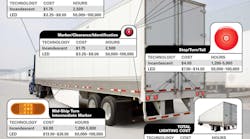Vehicle lighting is one of the Federal Motor Carrier Safety Administration’s most common CSA (Compliance, Safety, Accountability) vehicle violations, and one of the most obvious to spot. So, it is important that fleets inspect their vehicle lights at regular maintenance intervals to ensure they remain compliant with safety regulations.
“Interior LED lighting is essentially a case of set it and forget it,” says Brett Johnson, president and CEO of vehicle lighting manufacturer Optronics International. “It’s the closest thing to a no-maintenance component there is on a commercial vehicle.”
Exterior lighting, Johnson adds, is much more complex. Because external lights are exposed to a variety of environments, they are more prone to failure and require regular inspection to ensure proper operation.
Types of lights currently available
The commercial vehicle market currently includes four types of lamps:
- Incandescent – this electric light features a wire filament heated to a high enough temperature that it glows with visible light. This lighting type was once widely used, but is now the most dated and inefficient lighting option.
- Halogen – similar to an incandescent light, halogen lights feature a wire filament that is heated to produce light. A small amount of halogen gas allows it to work at a much higher temperature, increasing light output and extending the life of the bulb. Halogen lights last approximately three times longer than incandescent bulbs, but are less efficient than HID and LED bulbs.
- High-intensity discharge (HID) – HID bulbs are enclosed tubes filled with gases, an electrode at each end and an electric current passing through to emit light. HIDs produce more light than halogen lamps, and are more efficient.
- Light-emitting diode (LED) – LEDs are the newest technology, and are now considered standard by many OEMs and fleets, Optronics’ Johnson says. LED lighting offers the longest life of any of the lighting options, and provides illumination that most closely approximates the color temperature of natural sunlight.
“Whatever your expectations are for performance, durability and cost, there are lamps to match,” says Greg Parman, national sales manager at Maxxima. Maxxima is a manufacturer of commercial vehicle LED lighting. “Incandescents are in many cases the least expensive. LEDs tend to last the longest and consume the least in terms of electrical draw, and today are a much more affordable choice.”
LEDs were first introduced to commercial vehicle lighting in the late 1980s. At that time, most manufacturers and fleets found LED lighting cost prohibitive, and that prevented initial widespread adoption. However, as the cost of LEDs has decreased, more OEMs and fleets have adopted this lighting technology, and today LED lighting has become standard in many applications.
“LED technology can often come at a higher price point, but offers dramatically improved light output, lower current draw, exceptional durability due to its solid-state design and a significantly longer lifespan over its traditional lighting counterparts,” explains Paul Sniegocki, chief technology officer for Truck-Lite, a commercial vehicle and trailer lighting manufacturer.
LED lamps require only about 10 to 30 percent of the current needed to operate incandescent lamps. The reduced power consumption of LEDs enables vehicle designers and end users to repurpose the excess power for things like computers and other equipment.
“LED lighting has exponentially increased the operational efficiency of today’s commercial vehicles,” Optronics’ Johnson says. “We’re talking about product lifespan increases of between 50 to 100 times those of incandescent lamps – it’s an astonishing advancement.”
Vehicle lighting maintenance
Wherever there is an electrical connection, maintenance personnel should watch for signs of moisture and corrosion, Maxxima’s Parman says. This is especially important for exterior lighting, which is subjected to harsh road conditions, salt and road spray.
“Given the rigors of the commercial vehicle environment, Truck-Lite recommends using sealed, locking connectors treated with corrosion-preventative compound to ensure a completely sealed connection, especially in applications that are directly exposed to road spray,” Sniegocki says.
Full encapsulation of the electronics helps enhance the performance of LED lighting and protects against corrosive environments.
Commercial vehicles function in a wide variety of environments, and the amount of maintenance needed to keep exterior lights functioning correctly will vary depending on the geography, climate and road conditions.
“A warm and moist climate is going to cause a vehicle to age and corrode quicker than one in a cool, dry climate,” Optronics’ Johnson says. “[Rough] highways also negatively impact the lifespan of a vehicle’s electrical system by causing wiring and harness systems to flex incessantly.”
Vehicle lamps usually fail at their electrical connection, Johnson explains. Cutting corners by not replacing worn components when needed can mean a dramatic decrease in the lifespan of the vehicle’s lighting and electrical system.
Optronics recommends taking the following steps to identify and prevent lighting system failures:
- Start corrosion prevention early. Examine each vehicle’s lighting system, particularly in high-moisture and impact-prone areas, such as above the tires, to identify any unprotected wiring or connectors. Vulnerable aspects of the system should be augmented with protective coverings such as boots, plastic looms, moldings or tubing. Installing extra protection will help provide moisture resistance and reduce potential damage from gravel and road debris.
- Perform thorough pre-trip inspections. Coach drivers on how to perform a proper assessment. Investing in formal training empowers drivers and helps them understand their critical role in keeping CSA scores under control. During inspections, pay special attention to forward-facing surfaces and areas closest to the tires. Water and chemical mist can reach lighting and electrical components from eight to 10 feet above the road.
- Stick to a planned maintenance schedule. The common modular connectors in a trailer’s electrical systems are designed with reservoirs that hold water-resistant dielectric grease. As time passes, the silicone oils in the grease evaporate and dry out, enabling moisture to seep into the system. Regular inspections and replenishment of grease as needed help keep moisture at bay. Follow the lamp’s manufacturer recommendations for best practice lighting maintenance.
- Consider replacing incandescent lamps with LEDs. If using incandescent lamps, consider making the switch to longer-lasting LED lamps. Incandescent lamps have a shorter operating life and will require more frequent maintenance. Switching to LEDs can help reduce the risk of CSA violations due to unkept equipment and offer a higher light output than incandescent lamps.
Because incandescent and halogen lighting don’t have a solid-state design, the exact lifespan for these products is dependent on the environments in which they operate. But regardless of the environment, the actual lifespan of these products is only a fraction of the lifespan of LED lighting, Truck-Lite’s Sniegocki says.
Experts suggest replacing incandescent, HIDs and halogen lighting products immediately after failure or an outage takes place With LED lighting, the light should be replaced even in the event of a single diode failure, Sniegocki advises.
“Truck-Lite offers incandescent lighting with warranties ranging from one to three years, while many LED options are warrantied for life,” he adds.
An LED lamp that appears to be unlit can either be a problem with the lamp itself, or an indication of an issue with the electrical harness or connectors. There are tools available, such as Truck-Lite’s Light-Out Detection System, designed to help diagnose light failures, harness and connection failures.
Corrosion damage and physical degradation can result in total light outage, discontinuity and flickering lights. Specification of durable lighting and harness designs help ensure fleets will get the most out of lighting options. Corrosion-preventative products can help further maximize the performance of lighting and vehicle systems.
“Quality matters,” Parman says. “Look for lamps that are specifically designed and built to withstand the tough operating conditions here in North America. Make sure you only use DOT-approved lighting.”
Avoiding “for offload use only” lights and choosing high-quality LEDs from proven manufacturers can help fleets reduce the risk of unplanned downtime down the road.
Interior lighting requires less maintenance because it isn’t subjected to the same moisture and corrosion issues. But, fleets shouldn’t overlook interior lighting completely, Parman cautions.
“Bright, well-placed, long-lasting lamps in the cab, sleeper or cargo area are important to driver satisfaction, comfort and safety. Don’t overlook lighting as an opportunity to improve the driver’s work environment,” Parman says.
New trends in vehicle lighting
According to a study conducted by Grand View Research, government regulations for improved visibility and increasing penetration of energy-efficient light sources have driven growth in the vehicle lighting market. More fleets are adopting LED lamps, and there is a growing emphasis on technological innovations for more energy-efficient lighting technologies.
Maxxima, Truck-Lite and Optronics all agree that LEDs are becoming the industry standard, and are now spec’d on new tractors and trailers.
“We see OEM sales order ratios of LED lamps versus incandescent lamps now surpassing 90/10,” Optronic’s Johnson says. “At this stage, LED lighting is the norm and incandescents are truly becoming marginalized.”
Lighting manufacturers are working to make lights more efficient and ergonomic, helping to prolong the life of the lighting systems and their connectors. Truck-Lite’s Sniegocki says many of today’s OEMs are using connectors with a secondary lock that keeps the connection securely in place to provide additional moisture and debris protection. This technology helps further prolong the life of the electrical systems.
In the future, fleets can expect to see lighting solutions that are increasingly efficient with longer lifespans.
Conclusion
While LED lights have a higher upfront cost, it is important to analyze the total cost of ownership for the life of the lamp when selecting the appropriate vehicle lighting option.
To maximize their lighting investment, fleets should regularly check that lights are functioning properly during pre-trip inspections, and watch for signs of corrosion and moisture damage. Consider using grease to protect against moisture and protective coverings for vulnerable electrical connections to help extend the life of the vehicle’s lighting and electrical systems.
Taking these steps to ensure that vehicle lighting remains functional can help improve driver safety and create a better experience for the driver, as well as prevent CSA violations and unplanned downtime.




